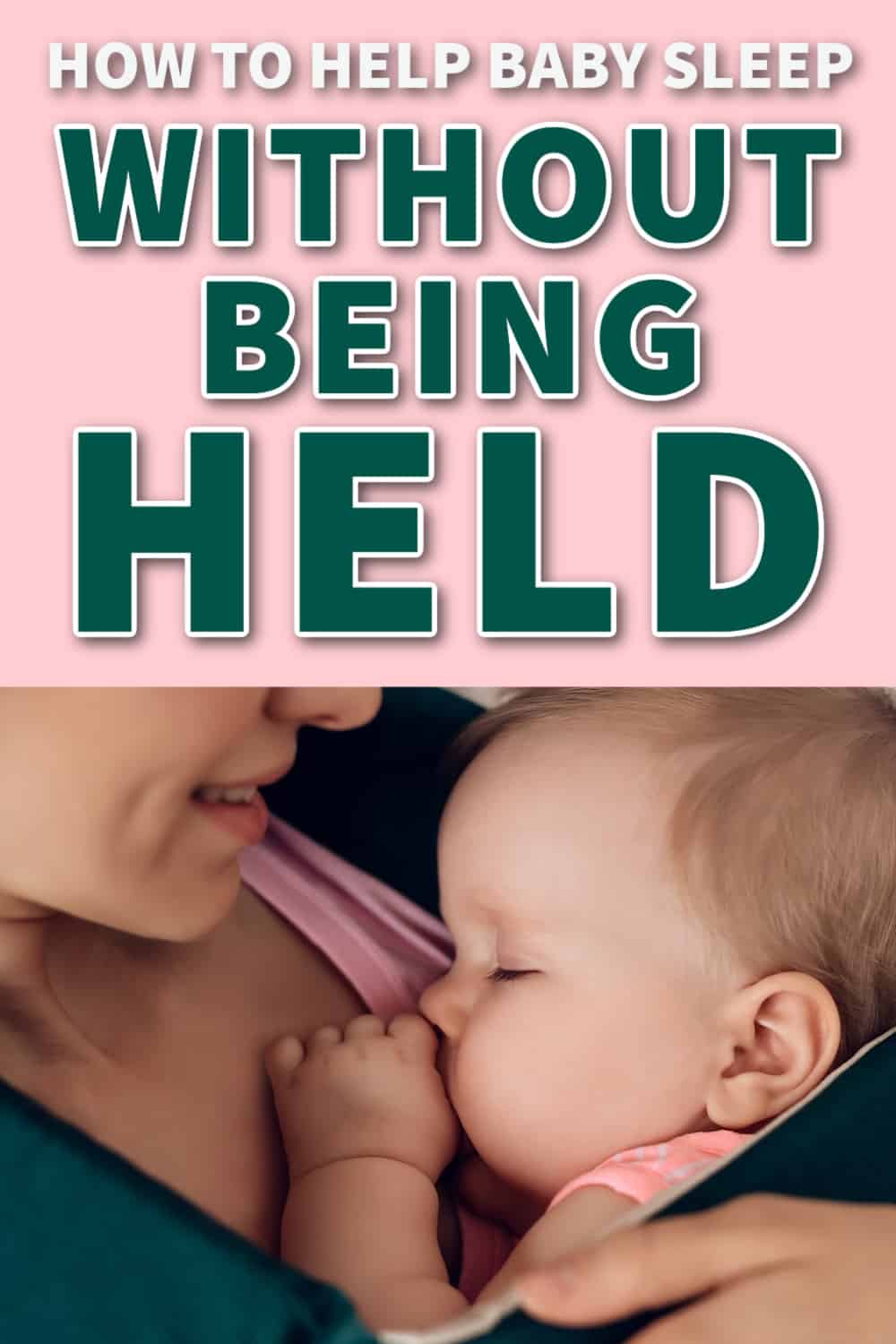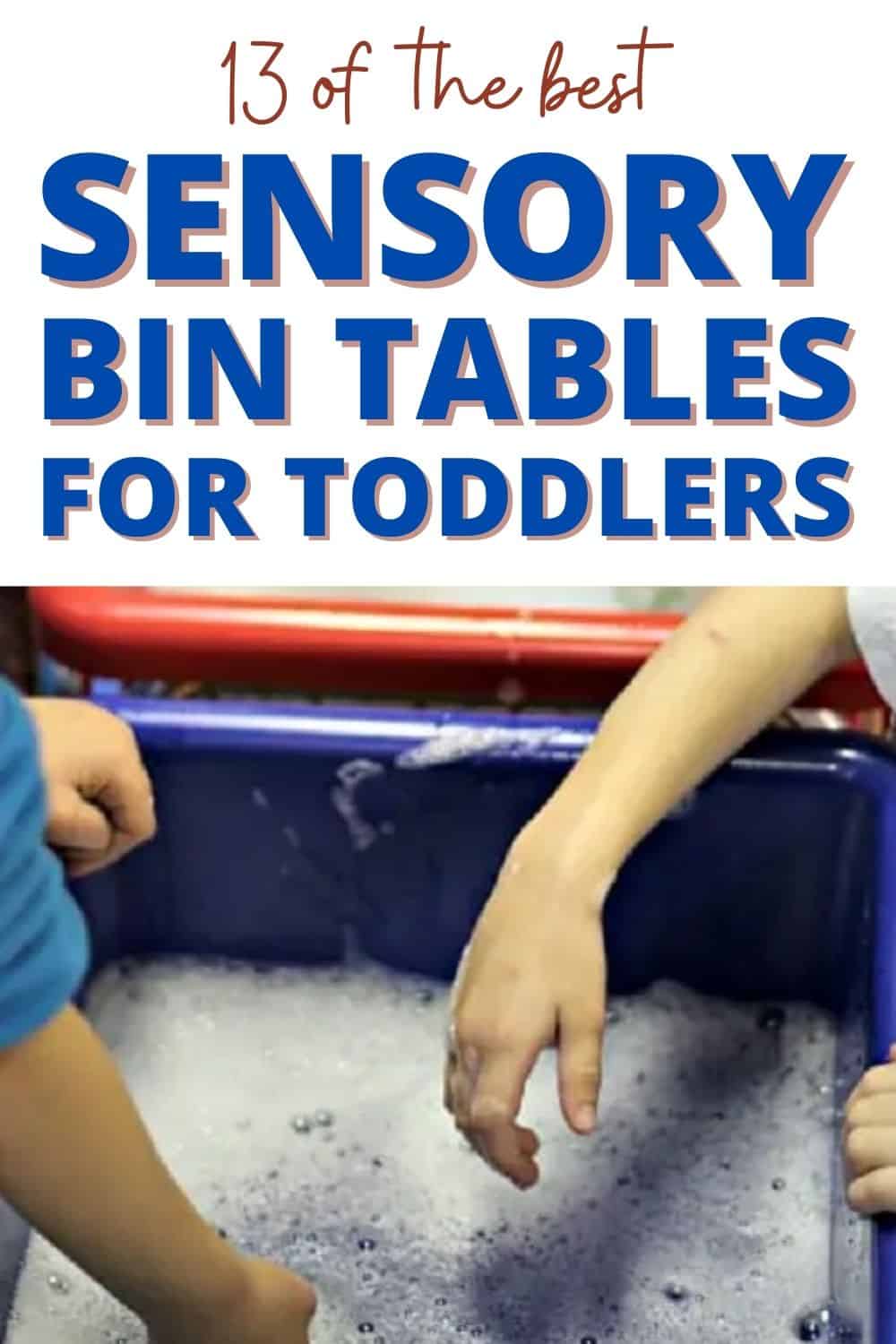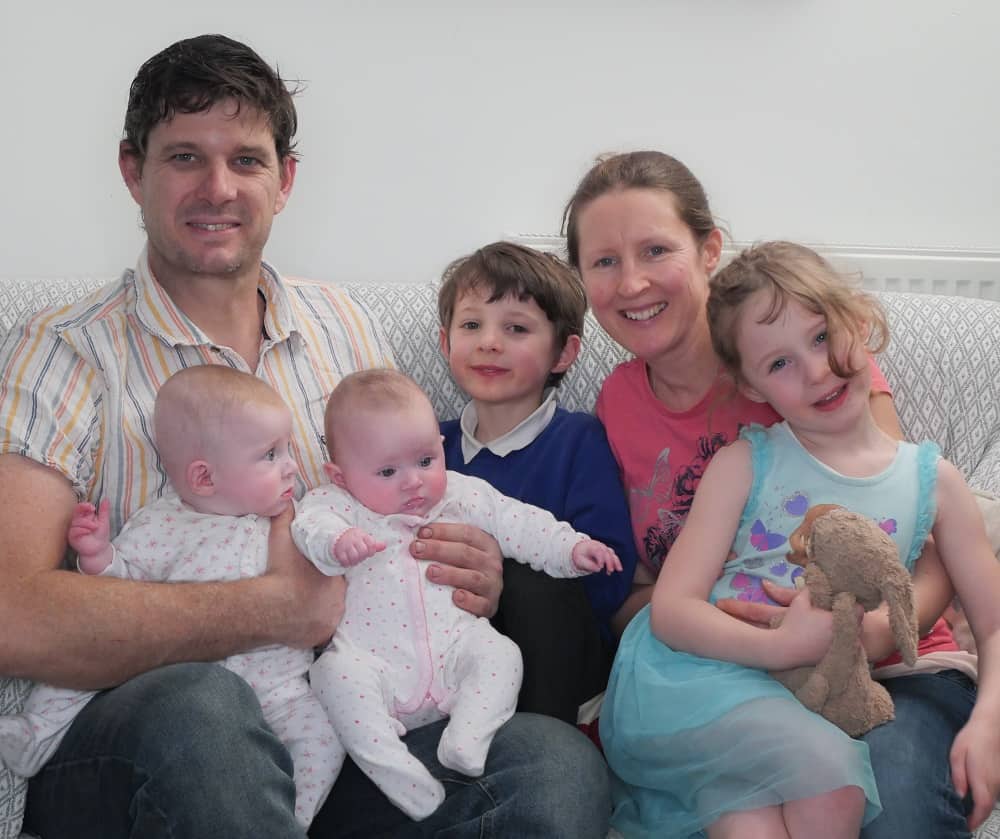Oh, a newborn’s sleep. I’ve discussed this topic numerous times, so today I’m going to answer one of the questions I’ve been asked the most by our dear first-time parents over the past few years (and that I, myself, asked countless times in those early days with my firstborn): how to get a newborn to sleep without being held? How?!
In addition to the million-dollar question, many other doubts arise, such as:
Is my baby going to stay this way for the rest of their life?
Do I have to get them used to sleeping differently?
Do I have to get myself used to sleeping differently, with a crooked neck and only using one hand for everything?
Does this happen ONLY to me?!
You’re not alone in this, don’t panic just yet. Well, if you’re reading this it’s probably because you’re getting a little desperate to put your little angel down for a few minutes to take a pee, get some decent sleep or rest your no-longer-feeling arm. You’re not the only one to whom this happens. In fact, this is a very common problem.
Fear not! You’ve come to the right place where you can learn exactly how to help your newborn sleep peacefully without being cuddled in your arms or on your chest.
You’ll also learn a bit more about why they want to take their naps on you 24/7 and whether it’s normal and even appropriate. Let’s get started, shall we?
Table of Contents
ToggleWhen Can You Teach Your Newborn Baby To Sleep Without Being Held
There are actually 2 parts to this particular newborn sleep question. Firstly, getting baby to sleep somewhere other than in your arms, having fallen asleep there. I.e. your newborn cries as soon as you put them down and is awake again.
Then there’s the falling asleep part. How can you get your baby to go from awake to fast sleep, without being held? This is commonly termed “self-soothing”.
Either way, the methodology is exactly the same.
When Do Babies Sleep Without Being Held?
This can happen from day dot. Under the right circumstances, which we’ll get onto below, there’s no reason why your newborn cannot sleep in their bassinet or crib or in another safe sleep environment from birth.
When Can Babies Fall Asleep On Their Own or “Self-soothe”?
This part is a bit trickier. Past the really sleepy first few days and weeks, when newborns are barely awake unless they’re eating, and even then normally have their eyes shut, your baby will probably need your help to fall asleep.
The same goes for falling back to sleep if they wake up in a place that isn’t your arms; your newborn will often need help.
The ability to fall asleep on their own or “self-soothe” normally comes around 3 months of age, but it’s not an exact science. In the video above you can watch my 6-week old settle to sleep on his own, despite the fact that I haven’t put in place all of the measures I talk about below. That’s not to say that he’ll do this every time he’s due to sleep, but I will try to allow him this opportunity as much as I can, by using the tactics listed below.
Hopefully, by 3 months he will have fully learnt this skill and be able to fall asleep without being held every time, just like his older brother and sister. Until then I will continue to help him settle to sleep.
The ability to self-soothe is key to getting your baby to sleep through the night and minimize the impact of sleep regressions and other developmental milestones that can be so disruptive.(My first two babies started sleeping through at around 3 months old and because they’d learnt this vital skill their sleep was only interrupted by illness and only occasionally teething.)
Self-soothing is a skill that your baby will learn eventually, whatever you do, and some babies will take longer to learn than others.
Why Should I Get My Newborn To Sleep Without Being Held?
This is mainly about your sanity and physical well-being. If your newborn won’t sleep without being held under any circumstances you’re very quickly going to be left exhausted. You need to start applying the techniques here so that your baby gradually learns to sleep and fall asleep in other places.
Independent sleeping and self-soothing will mean more rest for you
Not only in the short run, but in the long run too. As mentioned earlier, this ability to self-soothe is key to getting your baby to sleep all night long and this is due to the very nature of newborn sleep.
Babies wake several times in the night even if they’re not hungry or uncomfortable, both between sleep cycles as well as during light sleep stages. We also do the same as adults, but normally less frequently. This gives the brain opportunity to “check-in” that everything is ok. So if your baby is unable to self-soothe back to sleep, you will need to help them do that.
The same goes for sleep regressions and developmental leaps, which typically disrupt sleep, waking baby up briefly. If unable to self-soothe back to sleep, you’re going to need to help which will mean many nights of disrupted sleep for many months to come.
Finally, by getting your newborn to sleep without being held you’re reducing the risk of separation anxiety disorder developing. Early sleep problems can become later sleep problems.
P.S: Later in this post we’ll talk about whether a newborn can become spoiled by being allowed to sleep only in their mother’s arms. Keep scrolling!
Isn’t It Normal For A Newborn To Want To Be Held All The Time?
After giving birth to your little one, you cherish those happy moments with them in your arms and every little wiggle and grunt seems extra cute. But suddenly, you start to realize that the “sleep” factor is not so cute. It seems the only way for your newborn to be calm and content is for you to keep them curled up on your chest until they finally cuddle back to sleep. You’re left wondering: why does my newborn want to be held ALL the time?
Holding your newborn makes them feel safe and secure:
- Someone will be there to feed them whenever they need to eat
- The familiar heartbeat, smell, and warmth of mom is comfortable and soothing
- They sense that there will be no danger while sleeping if someone is holding them
But also, your newborn was used to being held, all the time; they’re accustomed to it. The womb provided a constant source of warmth, comfort and security with food on tap.
So although this behavior is completely normal, it doesn’t mean we can’t encourage it to change.
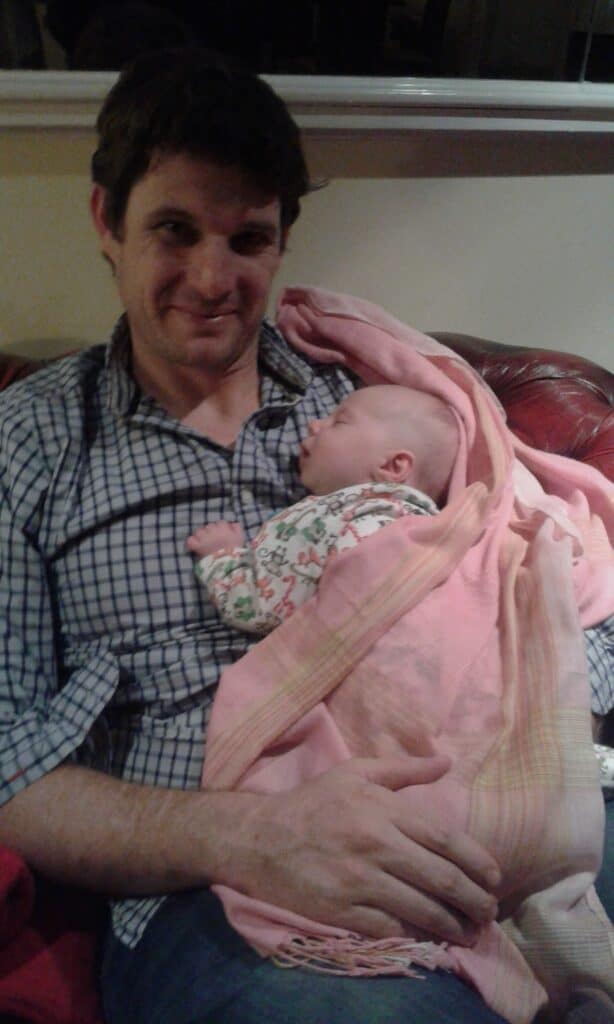
After 4 months of age, newborn sleep habits become increasingly difficult to change, so it’s crucial that for your own sanity more “independent” sleep habits are established which means learning how to get your newborn to sleep without being held.
Why Your Newborn Cries As Soon As You Put Him/Her Down
Every time you try to accomplish the never-ending mission of putting your baby down, they may go into full “mommy, are you seriously abandoning me?!” mode and wake up crying at the top of their lungs, little eyes wide open due to a lack of your cosy, warm embrace. So you return to your precarious position, sitting on the living room couch contemplating the times in your life when you could reach the TV remote control without having to move very, very slowly just so a mini-you wouldn’t wake up.
By waking up and crying, your baby is doing is trying to tell you that something is wrong. Crying is their main way of communicating that they need something and their needs aren’t actually all that complicated. Babies need:
- nourishment (milk)
- physical comfort (free of gas, warm enough etc)
- rest and sleep
- love and security
If your baby is hungry, gassy or uncomfortable and also tired, they will probably sleep in your arms quite happily, but nowhere else. As soon as you try to put your baby down, the security that you will fix those physical needs has gone. So they wake up.
But even if none of these things are troubling them, they still might wake up. Sleeping in your arms fulfills your newborn’s need for safety and security – all their needs can and will be instantly met while held in your arms. So when you try to put them down, in a crib, bassinet or anywhere else, as soon as their pajamas hit another surface that isn’t your chest their little developing brain can feel fear and vulnerability.
Can You Really “Spoil” A Newborn By Holding It To Sleep?
Spoiling someone implies giving them things they don’t need or giving them more than what they need, but for the first months of their life, babies only communicate what they need. They don’t really “want” for anything like older kids do. Newborns simply communicate what they need and remember how simple these needs are.
If your baby cries as soon as you put her down and you end up holding her to sleep that’s ok. It is normal for them to want to be held all the time and it is OK for your newborn to sleep on your chest if that’s the only way. You cannot spoil them by fulfilling this need. But by doing this all the time, for every nap and at night, you will be left exhausted. Plus, the longer you do this, the harder it will be to get your baby to sleep independently. The early you start practicing good sleep habits and learning how to get baby to sleep in a bassinet or crib, the easier it will be in the long-run.
Is It Dangerous To Hold A Baby To Sleep?
You shouldn’t now be concerned about “spoiling” your baby, but what about the safety aspect: is it dangerous to hold a baby to sleep? Yes and no. It is safe as long as you are awake. But letting your baby sleep on top of you while you are sleeping is potentially dangerous as you’re putting your baby at risk of SIDS. More on safe sleep guidelines further on.
STEP-BY-STEP: How To Get Your Newborn To Sleep Without Being Held
Here’s the step-by-step that, if followed hand in hand with patience and perseverance, will help you learn how to get your baby to nap without being held. Whether you want baby to sleep independently (i.e. not in your arms) or actually fall asleep and stay asleep somewhere other than your arms, the tactics are just the same.
#1 Ensure nothing is troubling your baby
As mentioned above, if in any physical discomfort you’re going to find your newborn won’t sleep without being held. This means if baby is hungry, gassy, too hold/cold or has a dirty or full diaper, as soon as you put them down, they’re almost certainly going to wake up.
So, before day naps or bedtime, try to ensure your baby has a good feed and has been well winded (this means burping baby at least once during the feed as well as afterward). Check baby’s diaper and make sure they’re at a comfortable temperature.
If your baby is particularly troubled by trapped wind or gut pain, you may need to dive a little deeper to find some gassy baby remedies. If you suspect reflux (commonly characterized by a high-pitched scream and excessive spit-up) then getting your newborn to sleep or nap without being held is also more challenging, as I discovered with my second-born. Getting to the cause and finding some reflux remedies is essential.
Overtiredness is also something to watch; although babies do need to stay awake in order to build up some “sleep drive” – the need to sleep due to tiredness – you don’t want them to become overtired. During the newborn phase, babies can only stay awake for short periods of time, with “awake times” of just 30 minutes at a few days old to around 2 hours at 3 months.
Following a newborn sleep schedule can help ensure babies get a good balance of sleep and awake time which gives your baby a much better chance of falling asleep without being held.
#2 Get Swaddling!
Swaddling means wrapping your newborn burrito-style with a blanket in a certain way. A good swaddling technique provides the deep pressure touch that the womb provided. It’s THE ultimate baby calmer.
Plus, it helps contain the Moro or startle reflex that can startle your baby awake, by keeping their little arms from flailing all over the place. I’m sure you’ve seen this reflex in action and can see how disturbing it is. Having finally got your baby to sleep in a bassinet or crib, the last thing you want is for them to turn into a startled starfish and wake right up again.
Swaddling effectively, so baby stays swaddled for longer than 5 nano-seconds, does take a bit of practice. You also need to understand how to swaddle safely, to avoid the risk of Sudden Infant Death Syndrome or SIDS as well as hip damage. Sign-up to my free swaddle course where you’ll get all the tips and tricks to swaddle your baby safely and effectively and become a swaddle pro. You’re welcome! 🙂
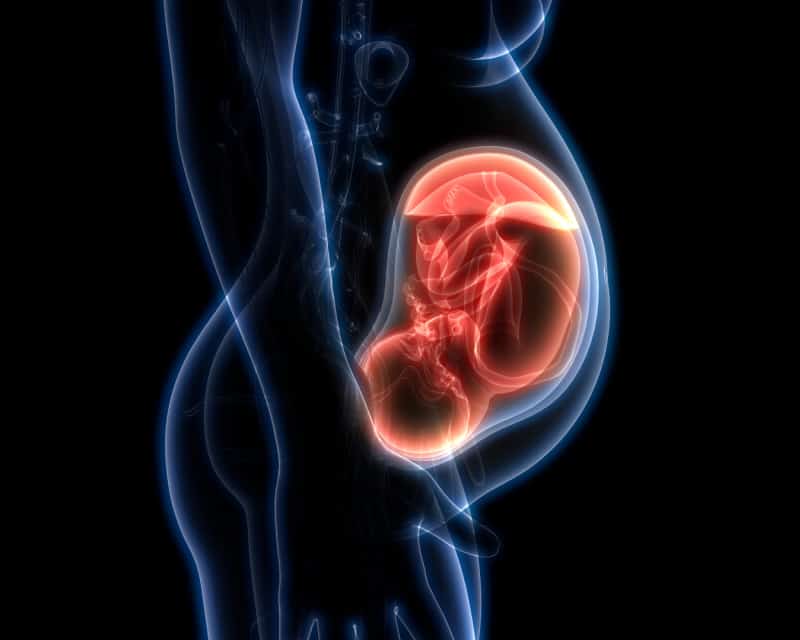
#3 Make The Best Sleep Environment Possible
This is all about mimicking the environment that your baby was so content and comfortable in: the womb. Swaddling is the most important and effective part. Next up are white noise and darkness: in the womb it was noisy and pitch black so these are things you want to recreate in order to help get baby to sleep without being held.
Darkness is key to getting baby to nap without being held in the day
A dark room allows the sleep-inducing hormone melatonin to do its job, since light suppresses it. Baby does not need to nap in a brightly lit room to reverse any day night confusion, that’s all myth.
Yes, in the extremely sleepy first few weeks when they will nap almost anywhere, but, sometime between 3 and 6 weeks, newborns become much more awake and alert and their eyes and brain are extremely sensitive to light. So while you may be able to get your newborn to nap without being held in a bright room, it won’t be long until they wake up.
That’s why darkness is so important to encourage longer naps in the day as well as to avoid early morning waking,
White noise soothes, helping baby sleep independently both day and night
The white noise of the womb is low-pitched, rumbly and loud (think volume of a decent shower) so this is what you want to aim for. While there are white noise audios on YouTube, there are plenty of inexpensive white noise machines designed to aid sleeping on the market (I’ve included my favorite in the baby sleep aid section below).
Familiar smells also aid soothing
Using your unwashed pillowcase or large T-shirt as a sheet in your newborn’s crib or bassinet can comfort and soothe them. Just ensure it’s tucked in tightly as, in line with safe sleep guidelines, there shouldn’t be any loose items in baby’s sleep space, to reduce the risk of Sudden Infant Death Syndrome or SIDS.
Babies not only find their mom’s smell soothing; their own smell can also do the trick so try not to overwash bedclothes and bedding. A little bit of their own scent can provide that missing element of familiarity that can help them sleep on their own. In addition, place your newborn in their bassinet or crib at other non-sleep times. That way you encourage them to feel comfortable in it, and will eventually transfer their own scent to this new environment.
#4 Create a Safe Sleep Wind-Down Routine
For safety – the ABCs
ABC stands for Alone, Back and Crib, the most important elements of the full safe sleep guidelines which are designed to minimize the risk of SIDS. If you’re wondering shere should my baby sleep, the ABCs are very clear on this. Baby should:
- Sleep alone with no toys, pillows or loose blankets or even crib bumber.
- Be positioned on the back – front and side-lying positions are the highest risk factor in SIDS so sleeping baby on their back is essential
- Sleep in a crib or bassinet, not in the same bed with you – bedsharing is to be avoided if at all possible.
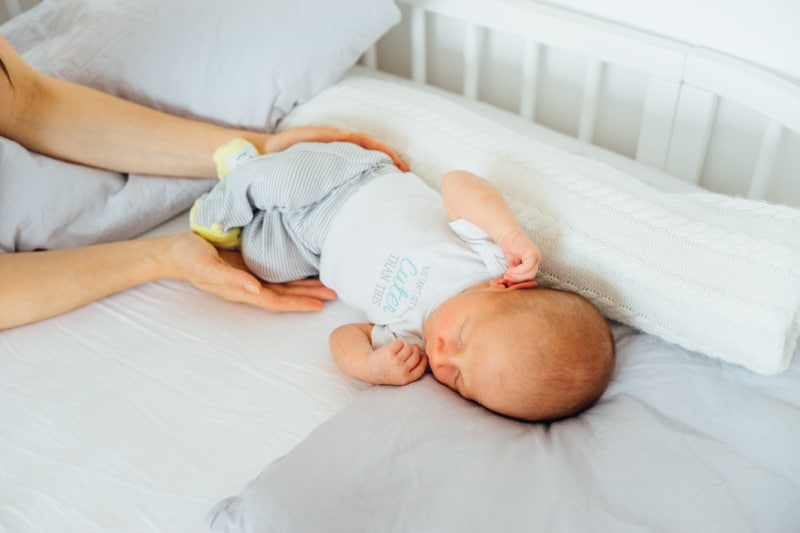
The routine part, which incorporate the 5 Ss
Babies and kids thrive on routine and a consistent and calm wind-down routine will help teach your baby to sleep without being held. Falling asleep is simply the last step of the routine and by repeating it time after time, the falling asleep part will come easier and easier.
It’s important to start the wind-down routine before baby is overtired. Once overtiredness hits, settling your baby will become increasingly difficult and you may find your newborn won’t sleep without being held. So after a good feed and a little activity, which can be as simple as kicking their legs while lying on the play mat, as soon as you spot agitation/irritation, staring into space/avoiding eye contact or yawning (key tiredness cues) or baby starts to fuss and squark, start winding down.
Check and change baby’s diaper if necessary while singing softly or playing a lullaby or calming music.
Then apply Dr. Karp’s 5 Ss – Swaddle, Shush, Swing, Side or stomach position and Suck:
- Swaddle baby (sign-up to our free swaddle course right here)
- Shush baby with white noise
- Swing baby in a side-lying position – you can rock your baby or try the “Jell-O head jiggle” for the ultimate calming technique
- Offer baby a little milk or a pacifier (but beware of overfeeding or excessive “comfort feeding“)
Settle baby in their crib or bassinet
Once baby has settled, try placing them in their crib or bassinet to see if they’ll fall asleep or, if asleep, stay asleep.
This is where a swinging bassinet can help as you can keep some of that calming motion going once you’ve transferred baby. Similarly, patting baby on the bottom while they’re lying on their side may help if they become unsettled having put them down. Just remember to gently roll baby onto their back once asleep.
It’s also important to pause a little and give baby the chance to settle fully to sleep. Pausing is next up…
#5 The “pause” to help baby learn to self-soothe & sleep without being held
So far all the steps above have set the scene for sleep. Baby is tired, but not overtired, well-winded, free of discomfort, isn’t hungry and is snug and securely swaddled. You wind baby down nicely and they’re drowsy and relaxed, ready to sleep.
Once you’ve placed baby in their crib or bassinet, they may not settle immediately. Or they may be content while you’re patting their bottom or swinging the bassinet but when you stop they seem to be waking up.
Pause.
Stay close to baby but give them a chance to settle. Your baby may stir, open eyes again or wriggle and move and that’s just fine. Your baby may not be awake at all but in the first very light stage of sleep so you don’t want to disturb them if this is the case.
Alternatively, your baby may fuss or even cry a little but as long as you’re sure there’s nothing troubling your baby (hunger or gas being the most common things), try to wait a little to see if they will settle.
You may need to help baby re-settle in your arms then try the whole process of putting them down down. It may take a few goes before baby stays asleep and if you get frustrated at any point, take a deep breath, take a break and try again. Or let baby sleep on your chest and try again at the next nap.
If baby wakes once asleep, it’s also important to pause and allow them the chance to settle back to sleep. They might need your help but they might not. You just need to give them that chance whenever possible.
Pausing is key to teaching your baby to self-soothe and therefore one of the most important baby sleep tips when it comes to a full night’s sleep for baby and you.
Suggestions for Baby Sleeping Aids:
To prevent your newborn from only sleeping when held at night or in the day, here are some sleeping aids that might work when used in conjunction with the methods above.
Products & Supplies that Help Babies Sleep
Swaddle blankets
Earlier we saw how beneficial it can be to swaddle your newborn in the process of teaching them how to sleep on their own. So you’re going to need a swaddling blanket which is simply a large square of fabric made out of cotton, bamboo muslin, or cotton rayon blend.
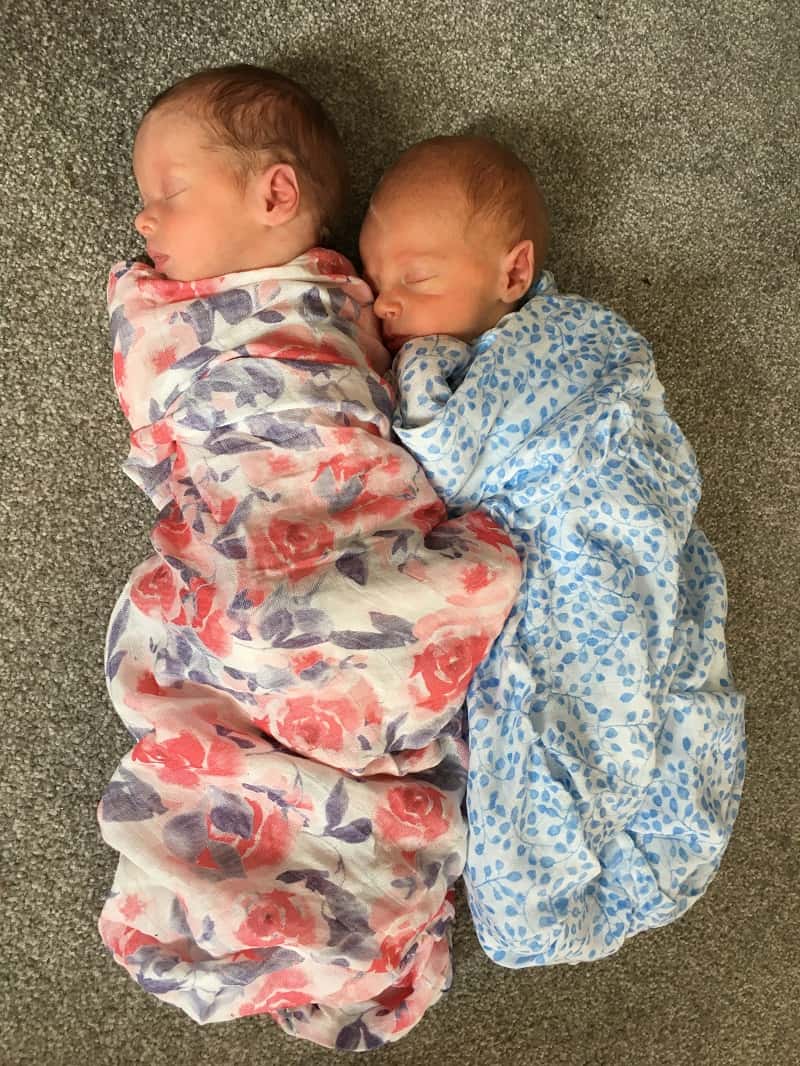
These Bamboo viscose swaddles from Aden + Anais are my absolute favorite, modeled beautifully by my twins above.
There are other more sophisticated models with pre-folds and/or Velcro for easier swaddling. There are some pre-folded swaddle recommendations here.
After your baby starts to roll over from their back to their tummy, you need to transition baby out of swaddling blankets into sleep sacks. Sleep sacks are basically a wearable blanket, similar to a sleeping bag. They aren’t nearly as restrictive as swaddling blankets but still provide a little pressure and comfort.
White noise
Using the right type of white noise at night and for day naps can help your newborn to sleep for longer periods of time and without being held. Not only is it calming and soothing, white noise helps tremendously to mask other sounds that can disturb your baby’s sleep.
I absolutely love this portable white noise machine from Dreamegg. It has lots of different audio to choose from, from music and the sounds of nature to plus various white noise options. I like the lullabies for wind-down and the “shhhhhhh” track for settling and sleep (I’m listening to this right now as I type and I can’t help but keep yawning…. ) It’s compact and once charged lasts a whole night and more.
Blackout curtains/films/blinds
Another factor that strongly influences your newborn’s sleep is the amount of light in their sleep space. To avoid light stimulating the brain and disturbing your baby, you want complete darkness. So dark you can’t see your hand when you hold it up in front of you.
There’s plenty of choice when it comes to blacking out a room – in the twins room at the moment we’ve lined the windows with this blackout film and hung some pretty blackout curtains in front. It definitely passes the hand trick!
For staying away, or random use in a different room, I love these portable blackout blinds from Tommee Tippee.
For more choice, check out 9 of the best blackout curtains on the market right now.
Pacifiers
Last but certainly not least, pacifiers. The OGs of products and supplies that help babies calm down when they lose their mind screaming, can also help them sleep? Yup! Hence this is the last of the 5 Ss mentioned above. The act of sucking makes them sleepy and relaxes them. However, if you can settle baby without a paci so much the better. Babies can love them so much they can be difficult to get rid of. If you do use one, try to remove it just before your baby falls asleep.
My Baby Will Only Sleep On My Chest!
Does your baby fall asleep on your chest after you breastfeed them? That’s absolutely normal too. Breastfeeding is an exhausting task for them, and filling their tummy makes them sleepy. Also, breast milk contains an amino acid called tryptophan that may help babies fall asleep. If a baby falling asleep on their mom’s chest wasn’t normal, breast milk would have caffeine in it (jeez, could you imagine that?).
There are also many parents who sleep with their newborn on their chest while lying down in order to get some rest, even if the baby still won’t let them change position. But… Is it dangerous for your baby to sleep on your chest?
Is It Safe To Let Your Baby Sleep On You?
While there are some professionals and mothers who claim that allowing your baby to sleep on your chest is risky for them since it can lead to tragedies such as SIDS, there are others who consider that it isn’t risky as long as you follow one condition: that you don’t fall asleep too.
This concern makes sense since if your baby adopts a position in which they can’t breathe properly, they can suffocate without you even realizing it. Allowing your newborn to sleep on your chest is a good way for you to bond with them, but always be alert. Better to be safe than sorry.
If your baby really will only sleep on your chest and you’re worried you’ll fall asleep too, you could always ask someone to watch the both of you while you sleep. It’s not ideal, but sometimes, needs must. If that’s the only way you can get some rest then you’ve gotta do what you’ve gotta do.
I Like Holding Baby During Naps
We all like holding our babies during naps. We love to feel our little angel close to us, and we would give everything to protect them and make them feel comfortable. If you don’t have a problem with your baby sleeping only in your arms, congratulations! You don’t have to be so worried. But if you do decide that you want to teach your baby how to sleep alone but want to hold them for the occasional nap, that’s fine too.
Getting your baby to sleep independently doesn’t mean abandoning them, ignoring any physical needs or eliminating their need for closeness to you. But it gives you flexibility and choice.
Newborn Nap Time Routine; To Hold Or Not To Hold?
As above, that’s totally up to you and your situation. With my firstborn, he had many a nap on my chest. I just loved those sleepy cuddles. But I didn’t have the demands of other children. Plus, I was fairly clueless in the beginning as to any other option.
Now with babies 3 and 4, twins to add to the complexity of it all, it’s almost impossible to have them sleeping on my chest. For starters, they already don’t both fit! But there are always so many other things I need to do, so independent sleeping is an absolute necessity.
So, hold your baby for naps as long as you want, as long as you don’t sacrifice your own physical and emotional needs.
Conclusion: While it may take some time and practice your newborn baby will sleep without being held… eventually
As adults, we tend to go to bed, sleep, get up the next day and carry on. Suddenly, a baby joins the family, and POOF! it takes everything apart. Turns out that they love to sleep in the day and be wide awake at night (so-called day-night confusion), only fall asleep in our arms – they just seem determined for us to get as little sleep as possible! Hopefully, you’re now not still wondering what to do if baby only sleeps when held.
Training your little angel to sleep without being held can, and most definitely will, take some time and practice. Yes, some parents are lucky and get their baby to adapt to sleeping on their own in no time, but don’t despair if that’s not the case. Parenthood is all about perseverance and patience. And remember everything is short-lived during the first year of life!
If I had a magic pill to cure for all the craziness that is newborn sleep, believe me, I would share it. But for now, hopefully you are a little wiser on taking those first steps to independent sleeping, so that you’re able to get a little more rest, or just get up to pee. Trust me, with consistency and perseverance your hard work will pay off.
